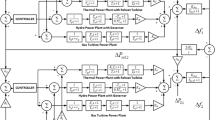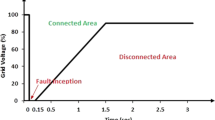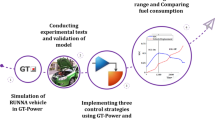Abstract
Takagi-Sugeno (T-S) fuzzy model offers a general and systematic framework to represent a nonlinear plant and provides an effective platform to facilitate stability analysis and control synthesis. This paper is concerned with the stability of the equilibrium point of a class of T-S fuzzy-model-based coupled control systems (TSFCCSs). Combined the Lyapunov method and graph theory, a systematic method to construct a global Lyapunov function for TSFCCSs is proposed, and then the substantial criteria of global stability at the equilibrium point with the condition of the system topology property are obtained. The theoretical results are suitable for the microgrid which is an application of the coupled control system. The significance of the presented results is that the global asymptotic stability of the microgrid can be achieved at the equilibrium point owing to the proposed secondary nonlinear T-S fuzzy control. Finally, one numerical simulation of a microgrid with six-generator seven-bus topology is presented to illustrate the progressiveness and feasibility of our results.








Similar content being viewed by others
References
Sevgen S (2019) New stability results for takagi-sugeno fuzzy cohen-grossberg neural networks with multiple delays. Neural Netw. 114:60–66
Jovic S, Miladinovic JS, Micic R, Markovic S, Rakic G (2019) Analysing of exchange rate and gross domestic product (gdp) by adaptive neuro fuzzy inference system (anfis). Phys A 513:333–338
Castro JR, Castillo O, Sanchez MA, Mendoza O, Rodriguez-Diaz A, Melin P (2016) Method for higher order polynomial sugeno fuzzy inference systems. Inf Sci 351:76–89
Zadeh LA (1965) Fuzzy sets *, Information. Control 8:338–353
Oscar C, Leticia A, Castro JR, Garcia-Valdez M (2016) A comparative study of type-1 fuzzy logic systems, interval type-2 fuzzy logic systems and generalized type-2 fuzzy logic systems in control problems. Inf Sci 354:257–274
Li S, Ahn CK, Xiang Z (2021) Command filter based adaptive fuzzy finite-time control for switched nonlinear systems using state-dependent switching method. IEEE Trans Fuzzy Syst. https://doi.org/10.1109/TFUZZ.2020.2965917
Li S, Ahn CK, Xiang Z (2019) Sampled-data adaptive output feedback fuzzy stabilization for switched nonlinear systems with asynchronous switching. IEEE Trans Fuzzy Syst 27:200–205
Sanchez MA, Castillo O, Castro JR (2015) Information granule formation via the concept of uncertainty-based information with Interval Type-2 Fuzzy Sets representation and Takagi-Sugeno-Kang consequents optimized with Cuckoo search. Appl Soft Comput 27:602–609
Sanchez MA, Castro JR, Ocegueda-Miramontes V, Cervantes L (2017) Hybrid learning for general type-2 TSK fuzzy logic systems. Algorithms 10:99
Takagi T, Sugeno M (1985) Fuzzy identification of systems and its applications to modeling and control. IEEE Trans. Syst. Man Cybern. 15:116–132
Jiang B, Karimi HR, Kao Y, Gao C (2020) Takagi-Sugeno Model Based Event-Triggered Fuzzy Sliding-Mode Control of Networked Control Systems With Semi-Markovian Switchings. IEEE Trans Fuzzy Syst 28:673–683
Shu F, Li M, Liu D (2019) Non-fragile H-infinity, control for markovian jump fuzzy systems with time-varying delays. Phys A 525:1177–1191
Lin C, Chen B, Wang Q-G (2016) Static output feedback stabilization for fractional-order systems in T-S fuzzy models. Neurocomputing 218:354–358
Wang Y, Zhang J, Zhang H, Xie X (2016) Adaptive fuzzy output-constrained control for nonlinear stochastic systems with input delay and unknown control coefficients. IEEE T Cybern. https://doi.org/10.1109/TCYB.2020.3034146
Wang Y, Zheng L, Zhang H, Zheng WX (2016) Fuzzy observer-based repetitive tracking control for nonlinear systems. IEEE Trans Fuzzy Syst 28:2401–2414
Ontiveros-Robles E, Melin P, Castillo O (2019) Relevance of polynomial order in Takagi-Sugeno fuzzy inference systems applied in diagnosis problems. In: 2019 IEEE International Conference on Fuzzy Systems. IEEE
Su X, Xia F, Liu J, Wu L (2018) Event-triggered fuzzy control of nonlinear systems with its application to inverted pendulum systems. Automatica 94:236–248
Rani PH, Navasree S, George S, Ashok S (2019) Fuzzy logic supervisory controller for multi-input nonisolated dc to dc converter connected to dc grid. Int J Electr Power Energy Syst 112:49–60
Li H, Liu H, Gao H, Shi P (2012) Reliable fuzzy control for active suspension systems with actuator delay and fault. IEEE Trans Fuzzy Syst 20:342–357
Zhou H, Song J, Li W (2020) Razumikhin method to stability of delay coupled systems with hybrid switching diffusions. Nonlinear Anal Hybri 38:100934
Coletta T, Jacquod P (2016) Linear stability and the braess paradox in coupled-oscillator networks and electric power grids. Phys Rev E 93:032222
Zheng C, Sun N, Zhang H (2019) New stochastic synchronization criteria for fuzzy Markovian hybrid neural networks with random coupling strengths. Neural Comput Appl 31:825–843
Wu Y, Hu S, Li W (2021) Exponential stability of stochastic Takagi-Sugeno fuzzy systems under intermittent dynamic event-triggered control. IEEE Trans Fuzzy Syst. https://doi.org/10.1109/TFUZZ.2021.3063813
Xu C, Yuan S, Zhang T (2018) Sensitivity analysis and feedback control of noise-induced extinction for competition chemostat model with mutualism. Phys A 505:891–902
Li X, Yang G (2017) Adaptive fault-tolerant synchronization control of a class of complex dynamical networks with general input distribution matrices and actuator faults. IEEE Trans. Neural Netw. Learn. Syst. 28:559–596
Li X, Yang G (2018) Neural-network-based adaptive decentralized fault-tolerant control for a class of interconnected nonlinear systems. IEEE Trans Neural Netw Learn Syst 29:144–155
Wang P, Wang R, Su H (2021) Stability of time-varying hybrid stochastic delayed systems with application to aperiodically intermittent stabilization. IEEE Trans Cybern. https://doi.org/10.1109/TCYB.2021.3052042
Liu Y, Xu H, Li W (2019) Intermittent control to stationary distribution and exponential stability for hybrid multi-stochastic-weight coupled networks based on aperiodicity. J Frankl Inst Eng Appl Math 356:7263–7289
Liu Y, Mei J, Li W (2018) Stochastic stabilization problem of complex networks without strong connectedness. Appl Math Comput 332:304–315
Li S, Zhang B, Li W (2021) Stabilisation of multi-weights stochastic complex networks with time-varying delay driven by G-Brownian motion via aperiodically intermittent adaptive control. Int J Control 94:7–20
Xu Y, Gao S, Li W (2020) Exponential stability of fractional-order complex multi-links networks with aperiodically intermittent control. IEEE Trans Neural Netw Learn Syst. https://doi.org/10.1109/TNNLS.2020.3016672
Wu Y, Zhu J, Li W (2020) Intermittent discrete observation control for synchronization of stochastic neural networks. IEEE T Cybern 50:2414–2424
Li MY, Shuai Z (2010) Global-stability problem for coupled systems of differential equations on networks. J Differ Equ 248:1–20
Xu D, Liu Y, Liu M (2021) Finite-time synchronization of multi-coupling stochastic fuzzy neural networks with mixed delays via feedback control. Fuzzy Sets Syst 411:85–104
Guo Y, Zhao W, Ding X (2019) Input-to-state stability for stochastic multi-group models with multi-dispersal and time-varying delay. Appl Math Comput 343:114–127
Wang M, Li W (2019) Stability of random impulsive coupled systems on networks with markovian switching. Stoch Anal Appl 37:1107–1132
Liu Y, Wang M, Chu D, Su H (2021) Feedback control based on discrete-time state observations on synchronization of stochastic impulsive coupled systems. Nonlinear Anal Hybri 39:1009877
Li W, Su H, Wang K (2020) Global stability analysis for stochastic coupled systems on networks. Automatica 47:215–220
Zhang H, Du X, Liu J, Kim H, Song H (2020) Graph theory-based approach for stability analysis of stochastic coupled oscillators system by energy-based synchronization control. J Frankl Inst Eng Appl Math 357:7581–7596
West DB (1996) Introduction to graph theory, vol 2. Prentice hall Upper Saddle River, NJ
Simpson-Porco JW, Dorfler F, Bullo F (2013) Synchronization and power sharing for droop-controlled inverters in islanded microgrids. Automatica 49:2603–2611
Dorfler F, Bullo F (2014) Synchronization in complex networks of phase oscillators: A survey. Automatica 50:1539–1564
Hwang C (1996) Sliding mode control using time-varying switching gain and boundary layer for electrohydraulic position and differential pressure control. IEEE Proc Control Theory Appl 143:325–332
Acknowledgements
This work is supported by the National Natural Science Foundation of China (No.61773137), the Natural Science Foundation of Shandong Province (Nos.ZR 2019MF030 and ZR2018PEE018), China Postdoctoral Science Foundation (No. 2018M641830).
Author information
Authors and Affiliations
Corresponding author
Ethics declarations
Conflict of interest
There are on conflicts of interest.
Additional information
Publisher's Note
Springer Nature remains neutral with regard to jurisdictional claims in published maps and institutional affiliations.
Rights and permissions
About this article
Cite this article
Liu, J., Cui, Y., Song, H. et al. Stability analysis of T-S fuzzy-model-based coupled control systems with nonlinear T-S fuzzy control and its application. Neural Comput & Applic 33, 15481–15493 (2021). https://doi.org/10.1007/s00521-021-06170-9
Received:
Accepted:
Published:
Issue Date:
DOI: https://doi.org/10.1007/s00521-021-06170-9




